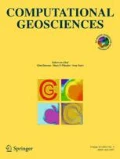Abstract
A major part of world hydrocarbon resources is located in fractured reservoirs. The identification of fractured reservoir parameters is essential for their optimal production. The Warren-Root model is one of the most fundamental models for fluid flow in fractured reservoirs. The simplified assumption of the Warren-Root model is not applicable for a finite reservoir, and transition zone cannot be detected in finite fractured reservoirs. In this study, the significance of the fractured reservoir boundary effect in the Warren-Root equation is investigated. Also, the numerical solutions of the Warren-Root model are proposed for all types of boundary conditions. Results show that in some cases, it is impossible to diagnose the transition zone in fractured reservoirs from dimensionless curves due to the transition zone and boundary effect interference. This interference is specifically observed in finite fractured reservoirs and it is a function of the interprosity parameter (λ) and reservoir dimensionless radius (rDe). This functionality is presented and discussed in the cases of constant production rate and constant pressure production conditions. The proposed equations are applicable to all types of boundary conditions.
Similar content being viewed by others
References
van Golf-Racht, T.D.: Fundamentals of fractured reservoir engineering, vol. 12. Elsevier, (1982)
Kuchuk, F., Biryukov, D., Fitzpatrick, T.J.S.J.: Fractured-reservoir modeling and interpretation. 20(05), 983-981,004 (2015).
Nelson, R.: Geologic analysis of naturally fractured reservoirs. Elsevier, (2001)
Ahmadi, M.A., Zendehboudi, S., Shafiei, A., James, L.J.I., research, e.c.: Nonionic surfactant for enhanced oil recovery from carbonates: adsorption kinetics and equilibrium. 51(29), 9894-9905 (2012).
Barenblatt, G., Zheltov, I.P., Kochina, I.N.Mechanics: basic concepts in the theory of seepage of homogeneous liquids in fissured rocks [strata]. 24(5), 1286-1303 (1960).
Warren, J., Root, P.J.: The behavior of naturally fractured reservoirs. (1963).
Kazemi, H.: Pressure transient analysis of naturally fractured reservoirs with uniform fracture distribution. 9(04), 451-462 (1969).
Stehfest, H: Algorithm 368: Numerical inversion of Laplace transforms [D5]. 13(1), 47-49 (1970).
de Swaan, O.A.: Analytic solutions for determining naturally fractured reservoir properties by well testing. Soc. Pet. Eng. J. 16(03), 117–122 (1976)
Jiang, J.J.M.: Exact solutions to problem of flow of fluid in naturally fractured reservoirs. 4, 263–269 (1977)
Zhongxiang, C., Lishang, J.: Exact solution for the system of flow equations through a medium with double-porosity. Sci. Sinica. 23(7), 880–896 (1980)
Bourdet, D., Gringarten, A.C.: Determination of fissure volume and block size in fractured reservoirs by type-curve analysis. In: SPE annual technical conference and exhibition 1980. Society of Petroleum Engineers
Da Prat, G., Cinco-Ley, H., Ramey Jr., H.: Decline curve analysis using type curves for two-porosity systems. Soc. Pet. Eng. J. 21(03), 354–362 (1981)
Chen, Z.: Flow of homogeneous and heterogeneous fluids through naturally fractured reservoirs. In. (1982)
Fetkovich, M., Vienot, M., Bradley, M., Kiesow, U.: Decline curve analysis using type curves: case histories. SPE Form. Eval. 2(04), 637–656 (1987)
Chen, Z.-X.: Transient flow of slightly compressible fluids through double-porosity, double-permeability systems—a state-of-the-art review. Transp. Porous Media. 4(2), 147–184 (1989)
Pratikno, H., Rushing, J., Blasingame, T.: Decline curve analysis using type curves-fractured wells. In: SPE Annual Technical Conference and Exhibition 2003. Society of Petroleum Engineers
Nobakht, M., Clarkson, C.R.: A new analytical method for analyzing linear flow in tight/shale gas reservoirs: constant-flowing-pressure boundary condition. SPE Reserv. Eval. Eng. 15(03), 370–384 (2012)
Popov, P., Qin, G., Bi, L., Efendiev, Y., Ewing, R.E., Li, J.: Multiphysics and multiscale methods for modeling fluid flow through naturally fractured carbonate karst reservoirs. SPE Reserv. Eval. Eng. 12(02), 218–231 (2009)
Syrtlanov, V., Kovaleva, E., Aleev, A.: Natural fractured reservoirs characteristics estimation based on production data using simplified correlation. Examples from Russia. In: SPE Russian Petroleum Technology Conference 2017. Society of Petroleum Engineers
Van Everdingen, A., Hurst, W.: The application of the Laplace transformation to flow problems in reservoirs. J. Pet. Technol. 1(12), 305–324 (1949)
Zakian, V.: Numerical inversion of Laplace transform. Electron. Lett. 5(6), 120–121 (1969)
Dubner, H., Abate, J.: Numerical inversion of Laplace transforms by relating them to the finite Fourier cosine transform. J ACM (JACM). 15(1), 115–123 (1968)
Schapery, R.A.: Approximation methods of transform inversion for viscoelastic stress analysis. Proc Fourth USNat Congr Appl Mech. 1962(2), 1075 (1962)
Hassanzadeh, H., Pooladi-Darvish, M.: Comparison of different numerical Laplace inversion methods for engineering applications. Appl. Math. Comput. 189(2), 1966–1981 (2007)
Author information
Authors and Affiliations
Corresponding author
Additional information
Publisher’s note
Springer Nature remains neutral with regard to jurisdictional claims in published maps and institutional affiliations.
Highlights:
• Effects of different boundary conditions on fractured reservoir production curves are investigated.
• In some specific conditions, the reservoir boundary effect interferes with the transition zone, which is due to the reservoir boundary limitation.
• Two relationships are presented to diagnose interference conditions at different inner and outer boundary conditions.
Rights and permissions
About this article
Cite this article
Zahedizadeh, P., Safari, Z., Ghaderi, A. et al. Transition zone diagnosis in finite fractured reservoirs. Comput Geosci 24, 1483–1496 (2020). https://doi.org/10.1007/s10596-019-09917-5
Received:
Accepted:
Published:
Issue Date:
DOI: https://doi.org/10.1007/s10596-019-09917-5




